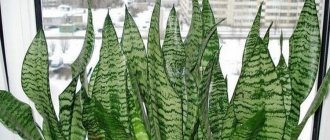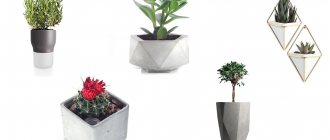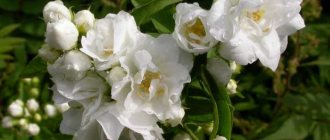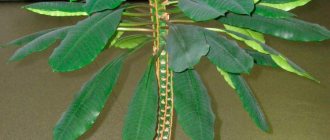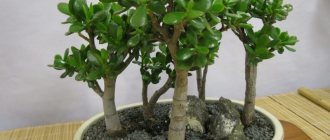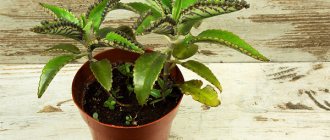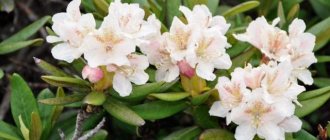Medicinal pelargonium or geranium
The most common indoor plant is geranium. Flower growers love it for its beautiful flowers, ability to heal and purify indoor air.
The most healing geranium is considered to be the one that blooms in bright red bouquets.
Pelargonium is endowed with astringent, soothing, and anti-inflammatory properties. Her abilities are known:
- normalize heart function;
- provide assistance in the treatment of acute and chronic gastrointestinal diseases;
- relieve pain from stomach and duodenal ulcers;
- help in the treatment of gastritis;
- get rid of dermatitis, boils, ulcers, carbuncles in the form of lotions and compresses.
Medicinal decoction of geranium
- 1 tbsp. Brew a spoonful of leaves or rhizomes of a houseplant with a cup of boiling water,
- keep in a water bath for 5-7 minutes,
- strain while hot through 3 layers of gauze,
- squeeze, then add water to the initial volume.
Drink 1 tbsp. l. three times a day a quarter of an hour before meals. To get rid of external problems, the broth is diluted with water 2 times.
From pressure
A treated infusion of the plant's roots is most often drunk to lower blood pressure and solve problems of the heart and blood vessels.
Geranium with honey
For pleurisy, you can simply chew 2-3 young geranium leaves twice a day, eating 1 tbsp. l. honey 30 minutes before meals.
The plant secretes such strong substances that it kills streptococci and staphylococci, and also has a calming effect, relieving stress and insomnia. Therefore, the best place for him is the bedroom.
What's the best thing to grow at home?
Some gardeners prefer to grow one or more types of plants in their home. Typically, it depends on their preferences. However, there are people who believe in omens and plant plants that symbolize something or have positive properties.
The question of which flowers are best to plant at home interests many, but there are specimens that lead in this extensive list:
- Hibiscus or as it is also called “Chinese rose”. Almost any rosacea is associated with love, tenderness and beauty. Therefore, if you want love and harmony to always reign in your home, plant a hibiscus. This beautiful bush with fragrant flowers will create a spring mood even in winter;
- orchid. Another flower with love energy. Its presence helps cleanse the aura, improves mood, and it is unpretentious in care, you just need to follow simple rules;
- lavender. Planting lavender at home is recommended for those who have health problems, in particular sleep disorders. In addition to the subtle aroma that lavender produces, it has a calming effect. These healing properties have been known for a long time, so lavender branches are dried and made into fragrant sachets, which are laid out in the closet with clothes;
- geranium. Small flowers with a specific smell have a beneficial effect on their owners. Their sleep is normalized, their mood improves, and colds occur less frequently. Due to the persistent smell, it is not recommended to place geraniums in the bedroom; the ideal option is a window sill in the living room or kitchen;
- violets. These colorful flowers delight the eye with an abundance of shades. It is a rare species of houseplants that can boast such diversity. The color of a violet directly affects the energy of its owner. Thus, blue violet nourishes creative people with inspiration, pink violet supports a romantic atmosphere, white violet personifies purity and cleanses the house of negativity. Violets are difficult to care for, but their beauty is so captivating that flower growers willingly grow them.
When choosing house plants, you should determine what is more important specifically for you: their healing properties or ease of care. Often indoor flowers combine both qualities.
Pike tail
Another popular plant that is loved for its unpretentiousness is Sansevieria. It also has such unusual names as “mother-in-law’s tongue” and “pike tail”.
This humble indoor flower has rare medicinal properties, such as resisting adverse conditions. Therefore, during the rampant flu and other infectious diseases, mother-in-law’s tongue increases the resistance of the inhabitants of the house to all viruses.
Tincture recipe
The medicinal tincture is useful for inflammation of the appendages. To prepare it:
- Fill 1/3 cup with finely chopped sansevieria leaves;
- add vodka to the brim, pour into a container with dark glass;
- let it brew for 21 days in the refrigerator;
- strain through 3 layers of gauze, then store in the same bottle.
Take 1 tbsp. morning and evening after meals. Course – 14 days.
Tradescantia
The medicinal properties of tradescantia for problems with the gastrointestinal tract, sore throats, colds, even tuberculosis are well known.
The recipe for making the tincture is the same as described above. Drink 50 ml of tincture every 2 hours, diluting with the same amount of water before meals.
If you develop periodontal disease, chew the leaves of this plant and rub its juice into your gums.
For hematomas, cuts, and scratches, apply fresh Tradescantia greens to the sore spot.
Blooming indoor flowers
Flower growers are divided into lovers of flowering plants and those who do not. Blooming indoor flowers that are popular among gardeners include:
- hyacinth;
- azalea;
- camellia;
- begonia;
- balsam;
- geranium;
- hibiscus;
- calla;
- begonia and others.
Some of these plants do not bloom for long, others can delight with lush flowering for several months. Lovers of flowering plants have a huge choice - you can choose plants with small or large flowers, you can also give preference to certain colors.
Ficus
Ficus is considered one of the most useful indoor plants. This unpretentious flower perfectly purifies the air in the apartment and treats a huge number of diseases.
Compress
To prepare a decoction for a compress, first boil the greens for 3 minutes, brush with honey, tie on your back and chest, secure well, tie a scarf on top, and leave the compress overnight.
Ficus tincture
The medicinal tincture very well treats arthritis, radiculitis and osteochondrosis:
- pass the ficus leaf through a meat grinder,
- pour 100 ml of vodka,
- keep in the refrigerator for 2 weeks.
- filter through 2 layers of gauze, pour into a container with dark glass.
Warm in hot water before use.
Before going to bed, take a bath (39 degrees) with the addition of 200 g of salt, then rub the sore spot with tincture of indoor ficus, wrap yourself in a warm scarf. Course - 10 days.
Juice and vinegar
Warts and wen will disappear if you add 50 g of vinegar essence to 100 g of ficus juice. Make a hole in the patch, stick it to the wart, drop 2-3 drops of the mixture into the hole where the wart is peeking out.
The burning will begin immediately. If the burning sensation can be tolerated, then hold it for 10-12 seconds. If it burns very strongly, rinse quickly with water.
Watering
Each flower has its own regime and need for moisture, which is why, if the owner of the house is rarely at home, then the plants in his apartment should be unpretentious and easy to worry about when they are forgotten for some reason.
Some of the first “European” indoor plants were the trophies of sailors who, in the 15th century, plowed the ocean from continent to continent in dreams of bringing an unusual flower to its destination. It was then that it became clear that plants brought from warm countries needed very special care, otherwise they would die.
Thus, it is better for a novice gardener to choose either plants that need watering extremely rarely, and these are well-known cacti (albeit with small nuances), or those that are not afraid of the gulf and are even very happy about it.
Juncus and Cyperus are used to living in the swamp, and the fern will not pay any attention to the fact that there is water in its pot. The cactus should be watered once a month in winter, and in the warm season at least once a week , or even more often. In other cases, you will have to keep the regime of your flower in mind, otherwise it will be difficult for him. So, azaleas and indoor roses will die if you forget to water them for at least a couple of days.
Most plants need to be watered, except in special cases that are specified at the time of purchase, when the soil has dried 2 cm deep. You may be afraid to overwater your plants in the cold months, but the risk of overwatering a flower in the summer is much less.
Kalanchoe
Homemade ginseng is used to treat skin problems . Indoor Kalanchoe is good at treating ulcers, bedsores, fistulas, purulent infections in the form of boils, festering wounds.
Kalanchoe juice
To obtain medicinal juice, cut off the leaves and place them in the refrigerator for 7 days. After this, the juice is crushed, squeezed out, kept in the refrigerator for a day, then passed through 3 layers of gauze, sterilized, and preserved in jars.
It is best to store in the refrigerator for no more than a year. As a rule, 4 layers of gauze soaked in Kalanchoe juice are applied to the wound.
For anemia
Kalanchoe is often called a living tree. A living tree grows in almost every home, but not everyone knows that the “babies” that grow thickly on the leaves can be put in salads or simply eaten 1 tablespoon daily. This “dish” will help get rid of anemia and increase the body’s defenses.
For varicose veins
The tincture is recommended for use for varicose veins : rub your legs from bottom to top.
Kalanchoe ointment
To get rid of cervical erosion , insert tampons with ointment every 4 hours. The erosion will disappear within a week.
To make a medicinal ointment, combine lanolin with the sap of a living tree in a ratio of 5:3, then add 50 g of petroleum jelly.
Rating of the best indoor plants
| Nomination | place | plant | rating |
| 12 Best Houseplants | 1 | Aglaonema | 5.0 |
| 2 | Ficus benjamina | 4.9 | |
| 3 | Spathiphyllum | 4.8 | |
| 4 | Laurel Noble | 4.7 | |
| 5 | Begonia | 4.6 | |
| 6 | Dracaena | 4.5 | |
| 7 | Scheffler | 4.4 | |
| 8 | Pelargonium | 4.3 | |
| 9 | Orange tree | 4.2 | |
| 10 | Anthurium | 4.1 | |
| 11 | Sensevieria | 4.0 | |
| 12 | Sims' rhododendron | 3.9 |
Aglaonema
Rating: 5.0
Large, unique foliage will decorate any home. Aglaonema kills streptococcal infections and for these properties our experts included it in the rating of the best indoor plants. The plant fills the air with aeroins, which helps improve general condition, performance and reduce nervous stress.
You should only care for the flower while wearing gloves to avoid skin burns. The bright color attracts the eyes of children, so it is better to place Aglaonema as high and far from them as possible. The flower stems grow upward, and small flowers are collected in inflorescences. The color of the flower is represented by many options: from classic green to variegated red flowers (in bred hybrids). Flower growers love the plant for its elegance.
Advantages
- beautiful spotted color;
- eliminates depression;
- purifies the air;
- does not die in low light.
Flaws
- poisonous juice irritates the mucous membrane.
Ficus benjamina
Rating: 4.9
Ficus benjamina is included in our ranking of the best indoor plants due to its beautiful appearance and absolute ease of care. We consider it the best choice for those who do not want to pay much attention to their home flowers.
The preferred temperature range for the flower is 20-25 °C. At low temperatures, ficus begins to lose leaves en masse. During the heating season, it is not recommended to place it near heating devices to avoid drying out the foliage. According to customer reviews, ficus has a beneficial effect on the emotional state and perfectly complements the home environment. The best time to water is after the top layer has dried.
Advantages
- not demanding in care;
- grows quickly (+10-15 cm in 3 months);
- a large number of varieties;
- saturates the air with useful substances;
- healing properties of juice.
Flaws
- cannot tolerate cold;
- difficult to treat.
Spathiphyllum
Rating: 4.8
The plant belongs to the araceae family. Its homeland is South America. The flower has no stem. Instead, basal leaves grow directly from the soil in the form of a bunch. Spathiphyllum feels great and grows actively at temperatures no higher than 23 °C, and needs high humidity. Its leaves can reach 1.1 meters in length.
The flower was included in our rating of the best indoor plants for its incredible beauty and durability with good care. Users note that it is often chosen as a gift or house plant.
Advantages
- beautiful inflorescence in the form of a cob;
- luxurious long leaves;
- unpretentious to fertilizers;
- creates festive decor;
- blooms from March to September;
- natural air purifier;
- not demanding on lighting.
Flaws
- sensitive to drafts;
- attractive to pests.
Laurel Noble
Rating: 4.7
The indoor tree is tolerant of different types of soil, but is demanding of the constant presence of sufficient moisture. Outwardly, it resembles a dense deciduous shrub of rich green color. All parts of the plant contain laurel essential oil. In winter, Laurel Noble requires coolness, and needs bright lighting all year round. It tolerates direct sunlight well.
The tree was included in the ranking of the best indoor plants for its beneficial properties. Its owners can not only admire the beauty of the leaves, but also prepare the aromatic spice at home. Home gardeners note many diseases that can be cured by a simple infusion of bay leaves.
Advantages
- not picky about soils;
- tolerates the absence of light;
- disinfectant properties;
- improves appetite;
- normalizes digestion;
- calms the nervous system.
Flaws
- not detected.
Begonia
Rating: 4.6
The plant is divided into three types: tuberous, bush, deciduous. The first has become the most popular among flower growers. It was she who was chosen in the ranking of the best indoor plants for her unprecedented beauty and abundance of flowers. Begonia requires regular watering with soft water. The soil should be moderate. The flower does not like dryness, but also does not tolerate excessive moisture. The optimal temperature for active growth is 15°C.
Getting water on the leaves causes white spots to appear, so it should be avoided. Reviews from people indicate the presence of begonia in almost every home, which confirms its popularity. It pleases the eye and reminds of the warmth of the tropics.
Advantages
- beautiful leaf color;
- flowers up to 20-25 cm in diameter;
- does not require frequent transplantation;
- lush leaves and flowers.
Flaws
- does not tolerate drafts and direct rays of the sun;
- easily affected by mold;
- Water should not get on the leaves.
Dracaena
Rating: 4.5
The plant's homeland is the Canary Islands, so it really needs warmth (15-25°C). You should periodically let the leaves breathe by placing them under the shower. Dracaena grows actively in winter. At this time, she needs regular feeding 1-2 times a month. It should be remembered that it does not tolerate fluoride.
Dracaena is included in our ranking of the best indoor plants thanks to its incredibly voluminous green leaves and healthy juice. It strengthens the immune system and heart, and is included in many healing infusions.
Advantages
- unpretentious in care;
- transplantation once every 2 years;
- purifies the air;
- calms the nervous system;
- flower juice eliminates diarrhea;
- treats skin diseases.
Flaws
- requires a lot of spraying.
Scheffler
Rating: 4.4
Schefflera was selected by our experts as one of the best indoor plants for its abundant green foliage that will decorate any apartment. The plant's homeland is tropical rainforests in Australia and Southeast Asia. Therefore, in a home environment, it prefers the sunny side and sufficient humidity. Spraying the leaves is an integral part of good care.
Schefflera leaves resemble an umbrella. Inflorescences do not appear in apartment conditions. You can see them in the botanical garden. The leaves of the flower are not only green, but also variegated. If you plant several small bushes in a pot at once, a single plant with a strong trunk will form. Buyers are often satisfied with the decorative foliage plant.
Advantages
- quickly reanimated;
- graceful leaves;
- easy to care for;
- grows in light and dark places.
Flaws
- does not bloom at home.
Pelargonium
Rating: 4.3
The plant is divided into two types: low compact bushes with rich flowering and tall bushes with less abundant flowering. Pelargonium flowers are double and semi-double. The flower is characterized by a fast growth rate, resistance to drought, and low maintenance requirements. For its excellent combination of properties, pelargonium was chosen by our experts in the ranking of the best indoor plants.
In a home environment, it immediately attracts the eye thanks to its beautiful petals of different colors: white, pink, red, purple, etc. The peculiarity of pelargonium is that absolutely any representative of this genus is not demanding of attention and pleases with long, beautiful flowering.
Advantages
- unpretentious and graceful;
- medicinal properties;
- bright flowers;
- variety of colors;
- compact size.
Flaws
- not detected.
Orange tree
Rating: 4.2
The optimal location for the tree is south-eastern windows. The light-loving plant tolerates direct sunlight well. Beautiful flowering is possible only by maintaining the correct temperature: 15-18°C. In spring and summer, the tree especially needs frequent and abundant watering. Throughout the year, it is recommended to spray the leaves once a day.
The orange tree was included in our rating of the best indoor plants for its beneficial properties and beautiful appearance. Experts believe that it can decorate every home. Owners of this tropical plant love its wonderful aroma.
Advantages
- vitamin fruits;
- pleasant aroma;
- beautiful appearance;
- stands out for its bright fruits.
Flaws
- needs regular treatment for spider mites.
Anthurium
Rating: 4.1
The plant can grow up to 90 cm in height. Its flowering begins in February and ends in December. The most popular are hybrid flower forms, which differ greatly in size, leaf shape and color. We chose Anthurium in our ranking of the best indoor plants for its natural magnetism. A tropical plant loves moisture and plenty of light. For good growth, the temperature of its environment should not fall below 18 °C.
We believe that it is best suited for decorating office spaces, winter gardens and home interiors. Buyers often choose the following varieties: Robino, Saxo, Minnesota, Dacota, Avento, Vitara.
Advantages
- inflorescences last up to 3 weeks;
- heat-loving plant;
- easily propagated (by simple division);
- bright rich flowers.
Flaws
- does not tolerate drafts;
- gets sick from sudden changes in temperature;
- requires frequent spraying.
Sensevieria
Rating: 4.0
The plant is popularly known as “mother-in-law’s tongue.” The graceful leaves of Sensevieria grow exclusively upward. Their density makes them very strong. The flower was included in our rating of the best indoor plants for its best effect in purifying the air. This is confirmed by numerous reviews from plant owners.
For best growth, Sensevieria needs a large, voluminous pot. Its roots grow not deeper, but wider. Home gardeners note the extraordinary beauty of the plant’s leaves. Its tips resemble small claws, making the flower elegant. We consider Sensevieria to be the best indoor plant for a stylish modern interior.
Advantages
- purifies the air;
- durable;
- blooming in the form of delicate flowers;
- infrequent watering;
- rarely needs transplantation
Flaws
- lack of light is detrimental to inflorescences.
Sims' rhododendron
Rating: 3.9
The plant's homeland (Southern China) has high humidity and low temperatures. For its comfortable living in indoor conditions, it is necessary to create the same environment. The bushy flower can grow up to 13-30 cm in height. Once a week, rhododendron needs to take a bath: place the pot in water for 15 minutes so that the roots and soil are saturated with moisture.
With proper care, flowering begins in autumn and ends in spring. Our expert flower growers chose rhododendron in the ranking of the best indoor plants for its delicate lush blooms, which can create a holiday and comfort in any home.
Advantages
- variety of hybrid varieties;
- long flowering;
- delicate beautiful flowers.
Flaws
- with a lack of light, it loses color;
- drying out of the soil destroys it;
- demanding care.
Echinacea
This houseplant is recognized as the best healer for weakened immunity, treatment of smallpox, arthritis, mumps, burns, infectious diseases of the bladder and many others.
The flowers of this indoor plant are used to prepare the tincture. Echinacea can kill a large number of pathogenic viruses, bacteria, and fungi, as evidenced by studies conducted in Germany.
The tincture is sold at the pharmacy, which should be taken 5-10 drops 3 times a day.
Useful properties of flowers and plants
The plants growing in our homes have many beneficial properties. The most important of them are:
- They are able to harmonize relationships between family members or employees, if we are talking about any organization. Bring health and well-being to others.
- Some of the houseplants are considered useful for treating burns, cuts and inflammation. Cosmetic products are made based on their components.
- Green neighbors have the unique property of absorbing heavy metals and toxins from the air around us. They have the ability to collect excess dust and purify the atmosphere.
- Everyone knows that all indoor plants absorb carbon dioxide and instead release oxygen into the air. That is why flowers are irreplaceable inhabitants of rooms with poor ventilation.
- Nowadays, homes contain a huge number of household appliances that emit electromagnetic waves. Flowers in the house actively absorb them and restore atmospheric balance.
Agave
Aloe is considered the most famous home doctor. The leaves of this medicinal houseplant are applied to long-term non-healing wounds, burns, corns, and calluses. Or soak a piece of gauze in medicinal agave juice, apply it to the sore spot, change the bandage to get a positive result.
Many women make aloe face masks to clear the skin of acne and rashes.
What flowers are useful to keep near your workplace?
There is an opinion that indoor plants can neutralize harmful electromagnetic radiation from a computer monitor. Moreover, the most effective defender is called the cactus. However, neither a cactus nor any other plant can protect against electromagnetic radiation. It is not so much the radiation from the monitor that causes tangible harm, but the light from it. People who work at a computer for a long time experience burning and dry eyes, fatigue and insomnia.
It follows from this that planting indoor plants in the work area is worth it to improve air quality, and not to combat radiation. Pay attention to plants with high levels of humidification and air purification (chlorophytum, begonia). The more such plants, the better.
When working with a computer, it is important to rest your eyes. Take a break from work and admire the beautiful blooms or unusual leaf patterns. Plants create a cozy atmosphere at home and in the office, give positive emotions, and help fight stress. It is important that you like the plant. Pay attention to the design, make your workplace aesthetically attractive.
Choose unpretentious, shade-loving plants. They will not suffer if you go on an unplanned vacation, but will patiently wait for their owner.
For those who want to get everything at once, we recommend purchasing a florarium - a small garden of succulents in a closed glass pot. Constant humidity and temperature are maintained inside. You can buy a florarium ready-made or assemble it yourself.
Plants suitable for the workplace:
- peperomia;
- fittonia;
- tradescantia;
- philodendron;
- Crassula;
- aloe;
- aspidistra;
- cactus;
- Sansevieria.
Callisia
The golden mustache has become a favorite of many gardeners. He treats perfectly:
- Burns, lichens, ulcers, promotes rapid cleansing of purulent wounds;
- Diseases of the stomach, gall bladder, intestines;
- Diseases of the circulatory system;
- Metabolic disorders in diabetes and obesity;
- Joint diseases;
- Increases immunity.
Leaves or purple shoots are used to prepare the infusion. 3 different recipes at your service.
- Brew 1 large mustache leaf with 1 liter of boiling water for a day.
- Place 16 “knees” in a thermos, add boiled water, let it brew for 7 hours.
- Chop the leaf or shoots, add cold water, bring to a boil, leave for 6 hours.
The resulting product should be taken 1 tbsp. spoon, three times a day 30 minutes before meals.
Indian onion
Medicinal indoor onions have many names. You can recognize it by its wide leaves and large scaly bulb.
Hell root can replace a whole list of medications, but be careful, it is a very poisonous plant, so it can only be used externally.
It treats skin diseases and joint diseases well.
If you suffer from headaches , then regularly lubricate your temples with the juice of mature herbs. They say that the pain immediately subsides.
If you are suffering from radiculitis or rheumatism , then take the leaves of the plant, rub it well, lubricate the affected area, and wrap it in a scarf. Leave for 2 hours. You will feel a tingling sensation at first, but it will pass quickly.
Mucus can be used to lubricate herpes, warts, abscesses, cuts, tumors, and mastitis can be treated with compresses. In addition, Indian onions bloom beautifully, purifying the air from harmful bacteria. Look at the photo of the flowering plant.
How to choose the right indoor plants
Below we provide some useful tips for choosing a home flower:
- You should not buy plants that have been standing outdoors for a long time. They are often offered at a discount, but can quickly die once they arrive home.
- When choosing bulbs, you should carefully examine them. They should be firm without sprouts or holes.
- During the winter, plants should always be kept in plastic packaging or wrapped for protection.
- Soft leaves, space between the compost, protruding roots - all this should alert you and dissuade you from purchasing.
- Before purchasing, be sure to consult a gardener in detail about plant care. This will prevent an unnecessary purchase, because the flower may simply not suit your lifestyle.
- Find out whether the plant is prone to causing allergies and test all household members for its presence. Often it is the most beautiful flowers that are unsafe for people.
- Do not overload the room with a large number of flowers. They have some influence on each other and on humans.
